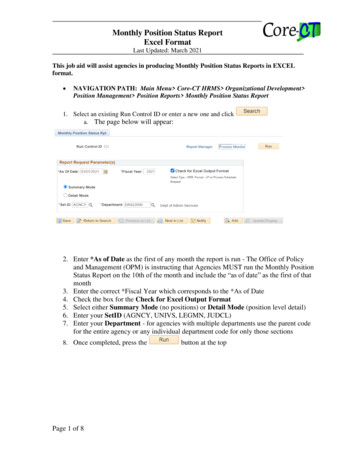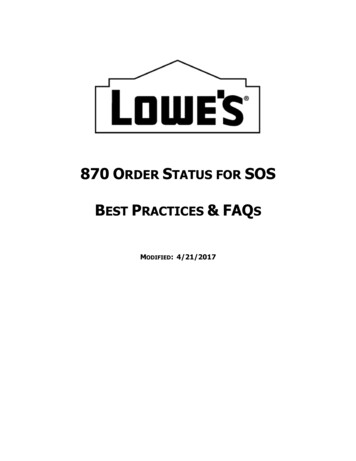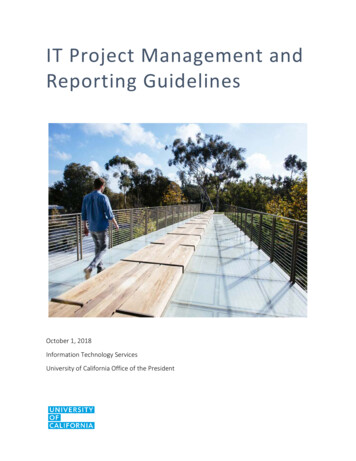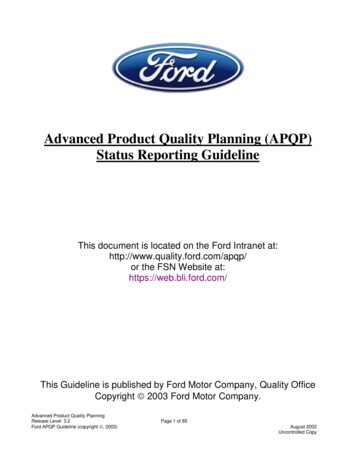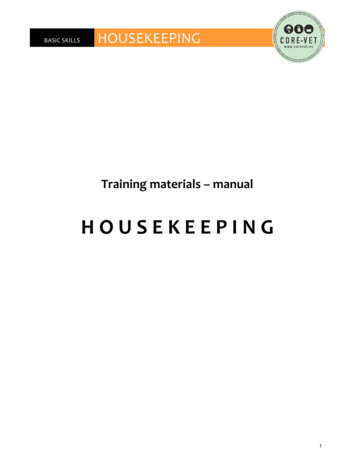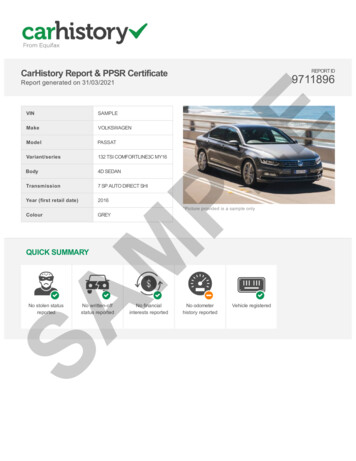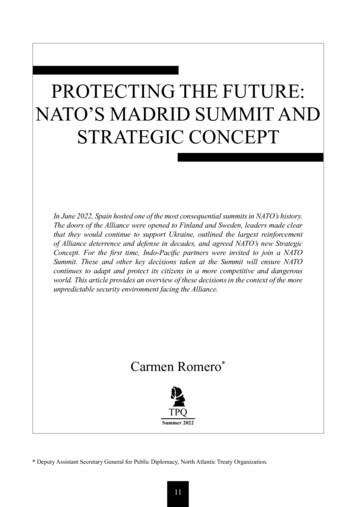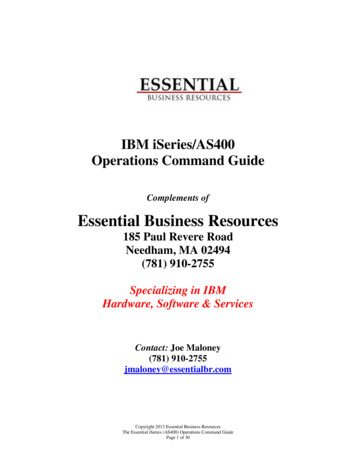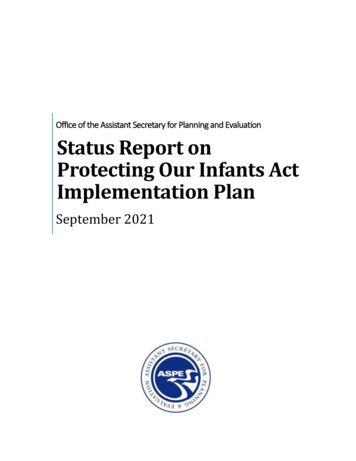
Transcription
Office of the Assistant Secretary for Planning and EvaluationStatus Report onProtecting Our Infants ActImplementation PlanSeptember 2021
TABLE OF CONTENTSACRONYMS . iiBACKGROUND . 1NEONATAL ABSTINENCE SYNDROME OVERVIEW . 2IMPLEMENTATION OF THE POIA STRATEGY RECOMMENDATIONS: HIGHLIGHTS. 3Data and Surveillance Efforts in HHS Programs . 3Clinical Interventions Research . 3Understanding of the Long-Term Impacts of NAS. 4Services for Pregnant and Parenting Women with SUD . 5Parenting Supports and Early Intervention . 5Training of Public Health Professionals and Health Care Providers . 6Public Awareness of SUD and SUD Treatment and Family Education . 7CONCLUSION . 8APPENDICESAPPENDIX A. Implementation Status Table . 9APPENDIX B. POIA Strategy Recommendations . 35REFERENCES . 38i
ACRONYMSThe following acronyms are used in this report and/or appendices.6BN6β-naltrexolAAPACFACLACOGACT NOWACYFAHRQAI/ANAIMASPEASTHOAmerican Academy of PediatricsHHS Administration for Children and FamiliesHHS Administration for Community LivingAmerican College of Obstetrics and GynecologyAdvancing Clinical Trials in Neonatal Opioid Withdrawal SyndromeHHS Administration on Children, Youth and FamiliesHHS Agency for Healthcare Research and QualityAmerican Indian/Alaska NativeAlliance for Innovation on Maternal HealthHHS Office of the Assistant Secretary for Planning and EvaluationAssociation of State and Territorial Health CSTEChild Abuse Prevention and Treatment ActComprehensive Addiction and Recovery ActHHS Centers for Disease Control and PreventionContinuing Education UnitChildren’s Health Insurance ProgramContinuing Medical EducationCenter for Medicare and Medicaid InnovationHHS Centers for Medicare & Medicaid ServicesCommittee on Native American Child HealthCar, Relax, Alone, Forget, Friends, TroubleCouncil of State and Territorial EpidemiologistsDASTDrug Abuse Screening TestEBPECHOEPSDTESCEvidence-Based PracticeExtension for Community Healthcare OutcomesEarly and Periodic Screening, Diagnostic and TreatmentEat, Sleep, ConsoleFDAFTCBHHS Food and Drug AdministrationFamily Treatment Drug CourtGPRAGovernment Performance and Results ActHBCDHCUP-USHEALHEDISHHSHEALthy Brain and Child DevelopmentHealthcare Cost and Utilization Project-United StatesHelping to End Addiction Long-termHealthcare Effectiveness Data and Information SetU.S. Department of Health and Human Servicesii
HRSAHHS Health Resources and Services Innovation Accelerator ProgramIntegrated Behavioral Health ServicesInternational Statistical Classification of Diseases and Related HealthProblemsIn-Depth Technical AssistanceInfant and Early Childhood Mental HealthHHS Indian Health ServiceInstitution for Mental DiseasesIntegrated Care for KidsInfants with Prenatal Substance ExposureInstitutional Review BoardLARCLong-Acting Reversible MMOMsmPINCMedication-Assisted TreatmentMATernaL and Infant NetworKMedication-Assisted Treatment Prescription Drug and Opioid AddictionMaternal and Child HealthMaternal, Infant, and Early Childhood Home Visiting ProgramMedical Marijuana LawsMaternal Mortality Review CommitteeMaternal Opioid MisuseMaternal Opiate Medicate SupportMaternity Practices in Infant Nutrition and nal Survey on Substance Abuse Treatment ServicesNeonatal Abstinence SyndromeNational Center on Substance Abuse and Child WelfareNIH Eunice Kennedy Shriver National Institute of Child Health and HumanDevelopmentNeonatal Intensive Care UnitNIH National Institute on Drug AbuseHHS National Institutes of HealthNeonatal Opioid Withdrawal SyndromeNational Survey on Drug Use and HealthOASHOB/GYNOMBOROOTCOUDOWHOWHPAOYHHS Office of the Assistant Secretary HealthObstetrics and GynaecologyU.S. Office of Management and BudgetHRSA Office of Regional OperationsOver-The-CounterOpioid Use DisorderOffice on Women’s HealthOffice on Women’s Health Prevention AwardOptional Yeariii
PK/PDPOIAPPWPQCPRAMSProject LAUNCHPSAobstetric PharmacoKinetics/PharmacoDynamicsProtecting Our Infants ActResidential Treatment for Pregnant and Postpartum Women grant programPerinatal Quality CollaborativePregnancy Risk Assessment Monitoring SystemLinking Actions for Unmet Needs in Children’s Health Grant ProgramPublic Service AnnouncementRCORPRDRFARPGPRural Communities Opioid Response ProgramRegional DirectorRequest For ApplicationRegional Partnership Grant ProgramSABGSAMHSASBIRTSUDSUPPORT ActSubstance Abuse Prevention and Treatment Block GrantHHS Substance Abuse and Mental Health Services AdministrationScreening, Brief Intervention, and Referral to TreatmentSubstance Use DisorderSubstance Use-Disorder Prevention that Promotes Opioid Recovery ActTATBDTEDSTechnical AssistanceTo Be DeterminedTreatment Episode Data Setiv
BACKGROUNDThe Protecting Our Infants Act (POIA; P.L. 114-91) was enacted on November 25, 2015. Pursuant toPOIA, the U.S. Department of Health and Human Services (HHS) published Protecting Our Infants Act:Report to Congress,1 which included a review of HHS activities, a set of recommendations, and a strategyrelated to prenatal opioid exposure and neonatal abstinence syndrome (NAS). Upon transmission of thereport to Congress, HHS solicited public commenta and subsequently published Protecting Our InfantsAct: Final Strategy2 with revised recommendations based on public comment. The POIA strategy informsNAS-related planning and policy across HHS.The Substance Use-Disorder Prevention that Promotes Opioid Recovery and Treatment for Patients andCommunities Act (SUPPORT Act; P.L. 115-271) was enacted on October 24, 2018. SUPPORT Act Section7062(a) requires the HHS Secretary to publish and periodically update “a report regarding theimplementation of the recommendations in the [POIA] strategy.” In 2019, HHS published Status Reporton Protecting Our Infants Act Implementation Plan,3 which included activities through August 2018.This update, which includes activities from September 1, 2018, through December 31, 2019, has beenprepared by the HHS Office of the Assistant Secretary for Planning and Evaluation (ASPE) incollaboration with the following HHS agencies and offices: Administration for Children and Families(ACF), Administration for Community Living (ACL), Agency for Healthcare Research and Quality (AHRQ),Centers for Disease Control and Prevention (CDC), Centers for Medicare & Medicaid Services (CMS),Food and Drug Administration (FDA), Health Resources and Services Administration (HRSA), IndianHealth Service (IHS), National Institutes of Health (NIH), Office of the Assistant Secretary for Health(OASH), Office of the National Coordinator for Health Information Technology, and Substance Abuse andMental Health Services Administration (SAMHSA).This update begins with a brief overview of NAS, followed by selected HHS programs and activitiesimplementing the POIA strategy recommendations. Appendix A presents a detailed update with newand ongoing HHS activities related to NAS and opioid use disorder (OUD) among pregnant andpostpartum women. For each activity, the table presents a lead agency, a brief description of theactivity, the funding status, milestones, and the relevant POIA strategy recommendation(s). Theimplementation plan addresses all 39 recommendations in the POIA strategy (Appendix B).aProtecting Our Infants Report to Congress: Summary of Public Comments and Final Strategy, 82 Fed. Reg. 24137,(May 25, 2017). Accessed June 15, 2020. egy.1
NEONATAL ABSTINENCE SYNDROME (NAS) OVERVIEWNAS is a nonspecific clinical diagnosis of physiologic withdrawal from tobacco, alcohol, prescriptionmedications, and illicit substances used by a mother during pregnancy.4,5 Although NAS is not specific toa particular substance, it is commonly used in the literature and clinically to discuss infants experiencingopioid withdrawal. In such cases, NAS encompasses a constellation of symptoms that primarily affect aninfant’s central and autonomic nervous systems, respiratory system, and gastrointestinal tract.5,6 NASincludes neonatal opioid withdrawal syndrome (NOWS), which is a more specific term for withdrawalsymptoms in opioid-exposed newborns.4NAS incidence has been increasing in the United States. From 2004 to 2014, the rate of United Statesinfants diagnosed with opioid withdrawal symptoms increased 433%, from 1.5 to 8.0 per 1,000 hospitalbirths.7 Data from the AHRQ shows that the annual number of NAS diagnoses nationwide continued torise through 2016.8 The rise in the incidence of NAS in the United States has correlated with increase inOUD diagnosis among pregnant women. The CDC found that between 1999 and 2014, the nationalprevalence of OUD among pregnant women increased 333%, from 1.5 cases per 1,000 deliveryhospitalizations to 6.5 cases per 1,000 (p 0.05).9Recommended first-line treatment varies by the severity of NAS symptoms. For newborns with mild NASsymptoms, first-line treatment is nonpharmacological care. For infants with moderate to severe NASsymptoms, nonpharmacological care is supplemented with liquid oral methadone or morphine.4 Bestpractice is to pair care for the newborn with NAS and care for the mother (i.e., treat the mother-childdyad) in close collaboration between pediatricians and OB/GYN providers.4,10,11 Clinical guidancerecommends that discharge plans for infants with NAS and their mothers pair supportive services suchas home visitation and early intervention along with parenting support.4 Developmental assessmentsare also recommended as part of routine pediatric care for infants with NAS diagnosis.4Polysubstance use is common among pregnant and parenting women who misuse opioids. Up to 56% ofpregnant women who misuse opioids and 87% of parenting women who misuse prescription opioidsalso use tobacco, alcohol, or marijuana.12,13 Guidelines and experts recommend that pregnant womenwith polysubstance exposure receive comprehensive set of services including “evidence-basedbehavioral, pharmacological, and social services to support the discontinuation of these substances.”4 Inaddition to clinical care, family-centered programs in particular include a range of supportive andcommunity-based services such as child care, transportation, housing, employment training, parentingeducation, and linkages to financial aid along with care coordination and trauma-informed care.142
IMPLEMENTATION OF THE POIA STRATEGYRECOMMENDATIONS: HIGHLIGHTSThe HHS programs highlighted below are organized by themes that cut across recommendations in thePOIA strategy. For a full list of all HHS programs relevant to the POIA strategy, see Appendix B.Data and Surveillance Efforts in HHS ProgramsHHS has incorporated NAS and prenatal substance exposure in current programs to support state andlocal data collection and surveillance efforts. As an example, HRSA supports NAS surveillance and datacollection through its Title V Maternal and Child Health Services Block Grant Program.15 Specifically,states have used Title V grant funds to collect NAS data and implement screening for substance use.SAMHSA has supported state and local programs to improve screening and assessment through itsResidential Treatment for Pregnant and Postpartum Women (PPW) program for mothers with substanceuse disorders (SUDs), their children and families. The PPW program has funded grants in six states(Georgia, Massachusetts, New York, North Carolina, Tennessee, and Virginia) to collect data on prenatalsubstance use and access to services. One of the primary goals of the PPW program is to develop stateinfrastructure and system improvements for family-centered services and continuum of care, and thatincludes data collection and screening.CDC has dedicated several resources to the identification and data collection of NAS at the state levelthrough its Perinatal Quality Collaboratives (PQCs). PQCs are single-state or multi-state networks of“perinatal care providers including hospitals, clinicians, and public health professionals working toimprove pregnancy outcomes for women and newborns through continuous quality improvement.”16CDC has provided technical assistance (TA) to several state PQCs on data collection of NAS, includingvalidating diagnostic-specific codes with hospital record data. CDC is also collaborating with the Councilof State and Territorial Epidemiologists (CSTE), a national organization that represents stateepidemiologists and provides technical assistance. Through this partnership, CDC will support up to eightstates to develop processes for NAS and prenatal substance exposure surveillance in state healthdepartments and to capture and link data on infants with NAS or in-utero substance exposure for theuptake of early intervention services.Clinical Interventions ResearchHHS is investing in studying clinical interventions for pregnant, postpartum, and parenting women whouse substances. NIH has supported investigator-initiated studies on optimal buprenorphine dosing totreat OUD and the effectiveness of extended-release naltrexone and medically-supervised withdrawalversus opioid agonist therapy in the prenatal and postpartum periods. Together with researching clinicalcare for mothers, HHS has been looking into new approaches to treating infants exposed to opioids inutero. The NIH National Institute of Child Health and Human Development (NICHD) Advancing ClinicalTrials in Neonatal Opioid Withdrawal Syndrome (ACT NOW) seeks to inform the clinical care of infantswho were exposed to opioids in-utero. Specifically, the ACT NOW Eat, Sleep, Console (ESC) clinical trial3
will compare usual care of infants with NOWS with a novel approach that does not use opioids. Inaddition, the ACT NOW Weaning Trial is evaluating how quickly infants with NOWS who need opioidagonist therapy can be weaned from opioids.Understanding of the Long-Term Impacts of NASWhile short-term neonatal outcomes of substance exposure such as low birthweight, small headcircumference and decreased brain volume are known, the longer-term impact of NAS onneurocognitive functioning and mental health as children reach preschool and school age is less clear.17Some of the early evidence of long-term outcomes of prenatal opioid exposure from observationalstudies highlights the myriad of mental health and psychiatric conditions children with NAS experiencelater in life.18 The HEALthy Brain and Child Development (HBCD) study, part of NIH’s Helping to EndAddiction Long-term (HEAL) Initiative,19 will examine normative brain, cognitive, behavioral, social, andemotional development following exposure to a variety of substances including alcohol and opioids,beginning prenatally through childhood and long-term. The study findings will help learn about, andprevent, negative effects of prenatal and postnatal exposure to certain drugs and risk for futuresubstance use, mental disorders, and other behavioral and developmental problems. In 2019, NIHawarded funding for Phase 1 of the HBCD study, an 18-month planning process during which awardeeswill test the experimental design and feasibility of approaches.In order to improve understanding of the long-term neurodevelopmental outcomes potentiallyassociated with NAS, CDC collaborated with the March of Dimes on a pilot project in Tennessee linkingMedicaid claims data to U.S. Department of Education data. This study found that children diagnosedwith NAS are more likely to be diagnosed with a developmental disability or speech and language delay,and more likely to have a learning disability at school age.20 The study results underscore howimportant early intervention can be for children diagnosed with NAS so they can receive the servicesthey need to succeed and overcome adversity.In the Fall of 2018, OASH convened experts to discuss the long-term needs of infants diagnosed withNAS. Since then, OASH has collaborated with experts to develop a comprehensive set of data elementsaimed to promote understanding of long-term needs of opioid-exposed infants and mothers. OASH isworking with private partners to explore opportunities to develop clinical resources and tools based onthese data elements. In addition, CDC and OASH published a review of six states’ laws mandating NASsurveillance demonstrated differences in case definition and specificity of required data elements thatmight affect the data available for monitoring of long-term outcomes and public health response toNAS.21Finally, CDC is leading an effort to standardize NAS case definitions used by state epidemiologists, whichwill aid the process of unifying NAS surveillance efforts for both short-term and long-term outcomes.CDC has collaborated with established state PQCs and CSTE on a position statement to standardize thedefinition of NAS used across United States jurisdictions. The statement was released in 2019 and iscurrently being disseminated to all states and territories.224
Services for Pregnant and Parenting Women with SUDHHS is focused on integrating care and providing a full continuum of services for mothers and childrenaffected by the opioid epidemic. In particular, there is a considerable investment in building the capacityof state and local communities to implement interventions, as they are the frontline in responding toemerging needs of families. Among federal service programs, SAMHSA’s PPW program is a flagshipfederal program dedicated to residential treatment of mothers with SUDs and their children. The PPWprogram provides linkages to support services and family-centered care in addition to residentialtreatment.Through the Center for Medicare and Medicaid Innovation (CMMI) and its technical assistance support,CMS has aided state Medicaid programs in developing accessible treatment and recovery supportservices and specialized SUD care. For example, CMS selected ten states to receive five years of fundingto implement the Maternal Opioid Misuse (MOM) Model. The MOM model seeks to improve quality ofcare and reduce costs for mothers with OUD and infants with NAS by supporting the coordination ofclinical care and the integration with other services critical for health, well-being, and recovery.CMS issued guidance in 2019 on how services provided to pregnant and postpartum Medicaidbeneficiaries with SUD residing in certain behavioral health institutions can be covered.23 This guidancewas issued per Section 1012 of the SUPPORT Act and is an important step in ensuring that women inresidential treatment can receive a continuum of services while residing in institutions. Women withOUD are more likely to be insured by Medicaid,24 which covers 75% of hospital visits related to maternalsubstance use and 80% of NAS-related hospital charges.25,26CMS is actively working on two additional guidance documents pursuant to the SUPPORT Act on theprovision of family-centered services in residential and outpatient settings. The first guidance documentaddresses family-focused residential programs for pregnant and postpartum women with SUD and theirchildren (SUPPORT Act, Section 8081). It will aid states in coordinating funding between Medicaid andchild welfare systems to provide a full continuum of support services including parent education,transition services and nonemergency transportation. CMS is also in the process of completing aguidance document to improve care for infants and their families through innovative paymentmechanisms (SUPPORT Act, Section 1005).Finally, HRSA, OASH and SAMHSA have partnered to plan a project that will integrate respective agencyprograms and systems of care at the state level to increase access to services for women, includingmental health, SUD treatment, primary care, and social services. These efforts will help state policyofficials towards improving access to coordinated, integrated care for SUD for the entire family. Familycentered treatment approaches which combine medication-assisted treatment (MAT) with a range ofsupportive and community-based services are considered to be most promising in promoting long-termrecovery for pregnant and postpartum women.14Parenting Supports and Early InterventionThe deficiencies in motor and cognitive development, executive functioning, poor educationalperformance and developmental delays that children exposed in-utero to opioids experience highlightthe importance of early intervention and other services beyond the perinatal period.17 SAMHSA’s5
Linking Actions for Unmet Needs in Children’s Health Grant Program (Project LAUNCH) addresses thephysical, social, emotional, cognitive, and behavioral needs of children ages birth to eight. ProjectLAUNCH creates and improves linkages to early intervention services in order to mitigate the impact ofprenatal substance exposure on families. Project LAUNCH grantees conduct developmental andbehavioral screenings across a wide array of early childhood settings to promote early identification ofdevelopmental concerns, and to link families with services.In 2019, CMS issued cooperative agreements for the Integrated Care for Kids (InCK) Model, a seven-yearpayment and delivery model for children which includes behavioral and physical health care withsupport services including early intervention. The model can also serve children impacted by the opioidepidemic, depending on the eligibility criteria for that each state will define in the planning process.Through InCK, eight states will design interventions for their local communities that align health caredelivery with child welfare support, educational systems, housing and nutrition services, mobile crisisresponse services, maternal and child health (MCH) systems, and other relevant service systems. TheInCK Model will aid providers to conduct early identification and treatment of children throughinterventions designed to increase behavioral health access.Another effort that builds capacity for early intervention through cross-system collaboration is ACF’sRegional Partnership Grant Program (RPGP). The RPGP is designed to improve the well-being of childrenaffected by parental substance abuse through the support of state interagency collaborations and theintegration of programs, services, and activities designed for children who are in, or at risk of, out-ofhome placements as result of a parent or caregiver’s substance abuse.Training of Public Health Professionals and Health Care ProvidersHHS has been working to increase the knowledge of community and health care providers on SUD as adisease and the evidence-based treatment approaches to SUD treatment. IHS has developed a range ofresources and provided trainings to support providers in addressing opioid misuse among women ofreproductive age in American Indian/Alaska Native (AI/AN) communities, including pregnant andpostpartum women. Since 2017, IHS has partnered with the Office of Women’s Health to developwritten recommendations on the screening, diagnosis, and management of OUD among AI/AN womenof reproductive age and AI/AN newborns, with the final guidelines published in 2019.In addition, IHS collaborated with the American Academy of Pediatrics (AAP) Committee on NativeAmerican Child Health (CONACH) to develop standardized screening guidelines for NOWS. Theseresources seek to educate providers to deliver evidence-based prevention and treatment in some of thenation’s most vulnerable minorities, tribes and tribal health organizations in rural and urban AI/ANcommunities.HHS has also supported programs to improve the capacity of a range of professionals who serve childrenimpacted by the opioid epidemic. Under Project LAUNCH, SAMHSA has funded trainings for medical,early intervention, and child welfare professionals on best practices and research related to treatmentof lactating women with OUD and infants with NAS both in inpatient and post-discharge settings.ACL is funding a virtual interdisciplinary training initiative aimed at providing supports to professionalswho serve young children with developmental disabilities as a result of NAS. Through this grant, ACLaims to train 16 interdisciplinary state teams on emerging knowledge and evidence-based practices6
(EBPs) in screening, monitoring, and coordinated care for children with NAS. ACL will provide technicalassistance for ongoing implementation of this initiative over a three-year period.Public Awareness of SUD and SUD treatment and Family EducationRaising public awareness of SUD as a disease can help dispel many of the myths associated withaddiction and can reduce stigma, one of the major barriers to both health providers participating in SUDtreatment programs and patient engagement and retention in treatment. As part of the NationalRecovery Month, SAMHSA created a Substance Use in Pregnancy initiative to develop educationalresource materials and web content that will be launched on SAMHSA’s website.CDC has partnered with the March of Dimes to create “Beyond Labels,” a toolkit designed to increasepublic awareness about the impact of stigma on women with SUD, infectious diseases, mental disorders,or other health conditions. An anti-stigma training plan and curriculum which aim to improveunderstanding of SUD and SUD treatment are currently under development. On September 18, 2018,CDC hosted a Public Health Grand Round on “Emerging Threats to Pregnant Women and Infants” thatincluded a presentation on surveillance to better understand the impact of the opioid crisis on infants.HRSA seeks to educate families about SUD, SUD treatment, and caring for babies with NAS diagnosisthrough home visitation. HRSA’s Maternal, Infant, and Early Childhood Home Visiting (MIECHV) Programprovides home visiting services for at-risk pregnant women and parents with young children up tokindergarten entry. Home visiting are evidence-based and voluntary. These services include training andtechnical assistance to help state programs improve home visitors’ capacity to support familiesexperiencing opioid use.While this is just a snapshot of HHS efforts to educate families about SUD and SUD treatment, theseactivities show the Department’s commitment to inform the public and raise awareness aboutNAS/NOWS and prenatal opioid exposure.7
CONCLUSIONHHS’s programs in surveillance, research, service delivery, and education represent a comprehensivepublic health response to the impact of the opioid epidemic on mothers and families. The programs andactivities in this status report address prevention, treatment and recovery for infants with NAS andmothers with SUD either through research, technical guidance or provision of direct services. Includedare not only activities during the prenatal and the postpartum period, but also efforts to evaluate thelong-term impact of NAS both on children and families and the systems that serve them.The themes presented above do not capture all HHS programs and activities implementing therecommendations of the POIA strategy. For a complete list of NAS-related programs across HHS, pleasesee Appendix A.8
APPENDIX A. IMPLEMENTATION STATUS HSASAMHSAACTIVITYFUNDINGArticle published in Pediatrics in August 2019 regarding cognitiveand behavioral impacts experienced by children who were exposedto opioids during pregnancy. The report found evidence that inutero exposure to opioids has long-term behavioral,developmental, and cognitive effects.In June 2019, hosted a technical expert panel on providingresources to SUD treatment programs on how to supportindividuals in treatment as parents, including guidance to SUDproviders on how to view clients as parents.Promotes awareness of early intervention services for families tomitigate impacts of prenatal exposure. The Center of Excellence forInfant and Early Childhood Mental Health Consultation will developweb materials and webinars in 2018 that prepare mental healthconsultants working in home visiting programs, childcareprograms, and preschools to offer children, families, and caregiversstrategies for effectively dealing with the consequences of prenatalexposure. These include behavioral strategies that promotehealthy attachment, stable and nurturing caregiving, emotionregulation, and others.Create and improve linkages to early intervention services forfamilies to mitigate impacts of prenatal exposure: Project LAUNCHgrantees continued developmental and behavio
1 BACKGROUND The Protecting Our Infants Act (POIA; P.L. 114-91) was enacted on November 25, 2015. Pursuant to POIA, the U.S. Department of Health and Human Services (HHS) published Protecting Our Infants Act: Report to Congress,1 which included a review of HHS activities, a set of recommendations, and a strategy related to prenatal opioid exposure and neonatal abstinence syndrome (NAS).
